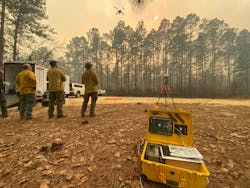NASA tests mobile air traffic kit during wildfire prevention operations
WASHINGTON - NASA researchers recently tested a mobile air traffic management kit for remote ground pilots across forests throughout Tennessee, Mississippi, Georgia, Florida, and South Carolina. During the testing, U.S. Forest Service pilots remotely operated Unmanned Aircraft Systems (UAS), or drones, to drop ping pong ball-sized plastic spheres that ignited on impact, precisely burning dead brush that acts as fuel to wildfires. The testing was in support of NASA’s Wildland Fire Management Initiative, NASA writes. Continue reading original article.
The Military & Aerospace Electronics take:
13 July 2023 - The Aerial Ignition Academy training, hosted by the U.S. Forest Service, in collaboration with the National Interagency Prescribed Fire Training Center, provided pilots with a chance to train using drones for prescribed burns, a wildfire prevention and land management technique that employs the controlled use of fire to burn fuels like dead brush and vegetation. During the training, researchers from NASA’s Advanced Capabilities for Emergency Response Operations (ACERO) project shadowed drone pilots as they trained in the field and collected data on the use of NASA’s mobile air traffic pilot kit. The kit alerted pilots positioned in forests throughout the five southwestern states to air traffic detected in the surrounding area. This enhanced their ability to avoid conflicts while conducting these prescribed burns.
Drone pilots are accustomed to monitoring their airspace by visually scanning for neighboring aircraft, listening for their engine sounds, and tracking local air traffic radio channels. The kit complements that awareness by providing a cohesive view of crewed aircraft and their location in the airspace.
Prescribed fires are currently set by a mix of firefighters on the ground using tools known as drip torches, and pilots in helicopters dropping ignition spheres over large areas of land. Igniting the burns with drones can remove firefighters from harm’s way by offering a safer approach to prescribed burns. Under NASA’s Scalable Traffic Management for Emergency Response Operations (STEReO) project, the U.S. Forest Service became a key collaborator during the initial stages of this technology, and continues to support the development of new versions that could enable the safe integration of drones into mainstream use for wildfire prevention and land management.
Related: Axon and Skydio partner on autonomous public safety drones
Jamie Whitney, Senior Editor
Military + Aerospace Electronics
